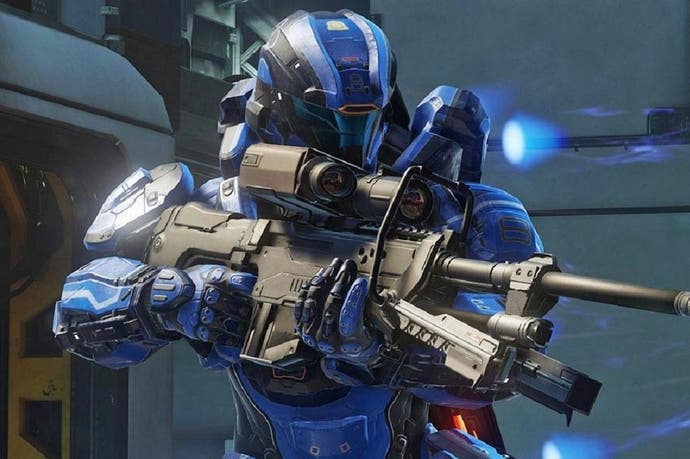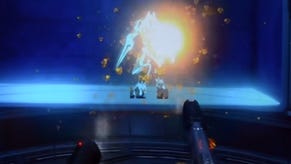Digital Foundry: Hands-on with Halo 5: Guardians
Has 343 Industries really delivered a locked 60fps across both campaign and multiplayer?
It's almost time once again to don the helmet of Sierra 117 - the Master Chief. 343 Industries returns for its second shot at the Halo franchise with Halo 5: Guardians. After recently attending a preview event for the game, we walked away with hundreds of gigs of direct feed lossless video, giving us one last chance to examine the title before it ships this October. While this isn't the final build we're looking at here, it's likely very close - and in this case, that's a good thing as the game is shaping up to be something very impressive.
With Halo 5, 343 Industries has developed a brand new engine designed from the ground up for this latest installment, built entirely around the capabilities of Xbox One. With improved lighting and materials, a range of new screen-space effects and a higher target frame-rate, Halo 5 is a visually impressive game. We had the opportunity to play two missions of the campaign, a match of the new Warzone multiplayer mode, and a few rounds of Arena, and with multiple embargoes having run their course, we can finally discuss all three.
Perhaps the most ambitious objective for Halo 5 is 343's stated aim in strictly targeting 60fps gameplay. The same promise was made with the Master Chief Collection, which didn't quite pan out, while Halo 5's E3 build suffered from plenty of performance dips, leaving us concerned that the studio's performance gambit wasn't going to pay off. In short, we were sceptical: after all, plenty of games promise the gold standard in console frame-rates, but few palpably deliver a predominately locked experience.
However, based this latest build, not to mention the marked improvement we saw at Gamescom, it's clear that significant effort has been made in making sure that the 60fps promise is delivered upon. After testing all three modes available here, we managed to uncover only a small handful of dropped frames. No matter how many enemies or effects are on screen, we see an almost complete adherence to 60 frames per second. Delivering a frame-rate this consistent is an incredibly impressive feat - the kind of achievement typically reserved for first-party Nintendo games or, more recently, Metal Gear Solid 5.
The question is - how is this achieved? The answer is simple; 343 has taken an approach similar to that of Rage, Wolfenstein The New Order, and WipEout HD - dynamic resolution scaling. By adjusting the resolution according to GPU load, Halo 5 is able to consistently reach its 16.67ms frame-time objective. It's a very impressive implementation too, bearing in mind how infrequent dropped frames are, to the point that they are essentially unnoticeable during play. Previous Halo 5 builds have utilised an adaptive v-sync, where torn frames are visible when the engine can't sustain its target frame-rate. In our latest captures we could only spot one solitary torn frame.
What this technology means for the player is a constantly changing resolution during gameplay, ranging from something in the region of 1152x810 all the way up to a full 1080p. Fortunately, based on what we've seen so far in this build, campaign mode gameplay tends to hang around 1344x1080, during which it's fair to say full HD is fleetingly attained during big set-piece battles, such as encounters with the giant Kraken in a later mission. Interior areas inevitably hold up better in this sense, with less strain put on the engine when the level design funnels the player in one direction. The pay-off is clear though; 60fps is locked at practically all times, while image quality shifts up and down the scale to ensure this consistency.
Halo 5's new Warzone mode is the real show-stopper though. With among the largest maps yet seen in Halo series' history, our hands-on with the Raid on Apex 7 stage had 24 players battling across a vast island - filled with caverns, woodland flourishes and mountainous outcrops. With all manner of vehicles, purchasable upgrades and MOBA-style mid-bosses in play too, this is Halo 5's engine stressed to a limit not seen in the campaign so far. Its scale sets it apart from the more traditional Arena mode too - it's a truly free-form multiplayer experience, calling to mind games like Planetside 2.
It's in this map that we see Halo 5's dynamic resolution hitting the lowest value mentioned above, giving a noticeably muddier image when compared to the game's other modes. In a sense this is unfortunate, given visibility over long stretches of terrain does takes a hit - particularly across foliage elements - though the vibrant colour palette of both squads helps to track the opponent at range. But crucially, 60fps is again a reigning standard in this taxing mode; gameplay remains as fluid as the Arena and Campaign here, despite hugely pushing the boat out on its scope of play.
A locked 60fps does not come cheap and it's clear that image quality is compromised in order to deliver this objective. This feels like an acceptable solution in this case as it benefits gameplay but those sensitive to image quality issues may be disappointed. The post-process anti-aliasing solution employed here works well enough at full 1080p but, as the resolution begins to dip, it can also result in a rather muddy-looking image.
Texture filtering also suffers greatly from this design choice. We're still not entirely clear how much of a toll texture filtering takes on the hardware generally but clearly, it was deemed too costly for Halo 5. More than the dynamic resolution, this setting has a significant impact on image quality, leading to a lot of highly blurry textures during normal gameplay. The open areas visible in the Warzone footage can look decidedly last-gen in places with blurry, shimmering foliage and poor texture filtering recalling the African plains of Halo 3.
Alpha effects also continue to operate at a lower quality, as we discovered in previous looks at the game. Explosions and weapon effects are rendered at a reduced resolution throughout, leading to some pretty noticeable pixilation during particularly heated sequences. Shadow quality also feels a bit hit or miss with the juxtaposition between real-time shadows and shadow-maps often a little jarring. In many ways, this feels like a visual evolution of Halo 4 at 60fps.
While these issues are significant, this is the reality of aiming for 60fps in a game like Halo 5. Dialling up frame-rate at the expense of image quality is a brave move and one that is sure to stir up controversy bearing in mind the visual trade-offs, but arguably, this is the best choice for a shooter - it's a decision that puts the quality of the gameplay first. Based on some of its marketing, we also suspect that Microsoft is aiming to position the new Halo as a major eSports franchise, where a rock-solid 60fps is absolutely crucial in a console title. Whether this can be sustained across the entire game remains to be seen, but based on the campaign stages and multiplayer modes we've tested so far, it's looking good. We'll have more on Halo 5 when it launches this October but for the time being, 343's efforts are shaping up nicely. We'll report back with a more detailed tech analysis as soon as we have access to final code.



















